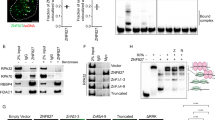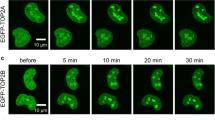Abstract
Ku antigen is necessary for DNA double-strand break (DSB) repair through its ability to bind DNA ends with high affinity and to recruit the catalytic subunit of DNA-PK to the DSBs. Ku-deficient cells are hypersensitive to agents causing DSBs in DNA but also to the DNA topoisomerase II (topo II) inhibitor ICRF-193, which does not induce DSBs. This suggests a new role of Ku antigen, that is independent of DSB repair by DNA-PK. Here we characterize the basis for the hypersensitivity of Ku-deficient cells to ICRF-193. Chromosome condensation and segregation, which are dependent on topo II, but also the catalytic activity of topo II in late S-G2 were inhibited to a comparable extent when ICRF-193 was applied to Ku-deficient cells or wild-type cells. However, mutant cells arrested in G2 by ICRF-193 treatment were unable to progress into M phase upon drug removal, although drug-trapped topo II complexes were removed from DNA and the two isoforms of topo II recovered their catalytic activity as in wild-type cells. The reversibility of G2 arrest was recovered by complementation of mutant cells with a human Ku86 cDNA. Notably, chromosome condensation was abnormal in Ku-deficient cells after suppression of the G2 arrest by caffeine, even in the absence of ICRF-193. These results reflect the involvement of Ku-antigen in the cellular response to topo II inhibition, more particularly in relieving G2 arrest caused by topo II inhibition in late S/G2 and the subsequent recovery of chromosome condensation.
This is a preview of subscription content, access via your institution
Access options
Subscribe to this journal
Receive 50 print issues and online access
$259.00 per year
only $5.18 per issue
Buy this article
- Purchase on Springer Link
- Instant access to full article PDF
Prices may be subject to local taxes which are calculated during checkout







Similar content being viewed by others
References
Anderson H, Roberge M . 1996 Cell Growth Differ. 7: 83–90
Andoh T, Ishida R . 1998 Biochim. Biophys. Act. 1400: 155–171
Andoh T, Sato M, Narita T, Ishida R . 1993 Biotechnol. Appl. Biochem. 18: 165–174
Andreassen PR, Lacroix FB, Margolis RL . 1997 J. Cell Biol. 136: 29–43
Austin CA, Marsh KL . 1998 BioEssays 20: 215–226
Burden DA, Osheroff N . 1998 Biochim. Biophys. Act. 1400: 139–154
Chen AY, Liu LF . 1994 Annu. Rev. Pharacol. Toxicol. 34: 191–218
Chen GL, Yang TC, Rowe BD, Halligan KM, Tewey KM, Liu LF . 1984 J. Biol. Chem. 259: 13560–13566
Clark DJ, Johnson RT, Downes CS . 1993 J. Cell. Sci. 105: 563–569
Cooper MP, Machwe A, Orren DK, Brosh RM, Ramsden D, Bohr VA . 2000 Genes. Dev. 14: 907–912
DiNardo S, Voelkel K, Sternglanz R . 1984 Proc. Natl. Acad. Sci. USA 81: 2616–2620
Downes CS, Clarke DJ, Mullinger AM, Gimenez-Abian JF, Creighton AM, Johnson RT . 1994 Nature 372: 467–470
Duguet M . 1997 J. Cell. Sci. 110: 1345–1350
Dvir A, Peterson SR, Knuth MW, Lu H, Dynan WS . 1992 Proc. Natl. Acad. Sci. USA 89: 11920–11924
Errami A, Smider V, Rathmell WK, He DM, Hendrickson EA, Zdzienicka MZ, Chu G . 1996 Mol. Cell. Biol. 16: 1519–1526
Gao Y, Chaudhuri J, Zhu C, Davidson L, Weaver DT, Alt FW . 1998 Immunity 9: 367–376
Gorbsky GJ . 1994 Cancer Res. 54: 1042–1048
Gottlieb TM, Jackson SP . 1993 Cell 72: 131–142
Gu Y, Seidl KJ, Rathbun GA, Zhu C, Manis JP, van der Stoep N, Davidson L, Cheng HL, Sekiguchi JM, Frank K, Stanhope-Baker P, Schlissel MS, Roth DB, Alt FW . 1997 Immunity 7: 653–665
Holm C . 1994 Cell 77: 955–957
Holm C, Goto T, Wang JC, Botstein D . 1985 Cell 41: 553–563
Ishida R, Sato M, Narita T, Utsumi KR, Nishimoto T, Morita T, Nagata H, Andoh T . 1994 J. Cell Biol. 126: 1341–1351
Jensen LH, Nitiss KC, Rose A, Dong J, Zhou J, Hu T, Osheroff N, Hensen PB, Sehested M, Nitiss JL . 2000 J. Biol. Chem. 275: 2137–2146
Kaufmann WK, Kies PE . 1998 Mutat. Res. 400: 153–167
Kimura K, Saijo M, Ui M, Enomoto T . 1994 J. Biol. Chem. 269: 1173–1176
Kimura K, Nozaki N, Enomoto T, Tanaka M, Kikuchi A . 1996 J. Biol. Chem. 271: 21439–21445
Meyer KN, Kjeldsen E, Straub T, Knudsen BR, Hickson ID, Kikuchi A, Kreipe H, Boege F . 1997 J. Cell. Biol. 136: 775–788
Mimori T, Hardin JA . 1986 J. Biol. Chem. 261: 10375–10379,
Mimori T, Hardin JA, Steitz JA . 1986 J. Biol. Chem. 261: 2274–2278
Morozov VE, Falzon M, Anderson CW, Kuff EL . 1994 J. Biol. Chem. 269: 16684–16688
Muñoz P, Zdzienicka MZ, Blanchard J.-M., Piette J . 1998 Mol. Cell. Biol. 18: 5797–5808
Nussenzweig A, Chen C, da Costa Soares V, Sanchez M, Sokol K, Nussenzweig MC, Li GC . 1996 Nature 382: 551–555
Patel S, Jazrawi E, Creighton AM, Austin CA, Fisher LM . 2000 Mol. Pharmacol. 58: 560–568
Roca J, Ishida R, Berger JM, Andoh T, Wang JC . 1994 Proc. Natl. Acad. Sci. USA 91: 1781–1785
Shen JC, Loeb LA . 2000 Trends Genet. 16: 213–220
Smith GCM, Jackson SP . 1999 Genes. Dev. 13: 916–934
Sundin O, Varshavski A . 1980 Cell 21: 103–114
Tanabe K, Ikegami Y, Ishida R, Andoh T . 1991 Cancer Res. 51: 4903–4908
Tuteja N, Tuteja R, Ochem A, Taneja P, Huang NW, Simoncsits A, Susic S, Rahman K, Marusic L, Chen J, Zhang J, Wang S, Pongor S, Falaschi A . 1994 EMBO J. 13: 4991–5001
Uemura T, Ohkura H, Adachi Y, Morino K, Shiozaki K, Yanagida M . 1987 Cell 50: 917–925
Vogel H, Lim DS, Karsenty G, Finegold M, Hasty P . 1999 Proc. Natl. Acad. Sci. USA 96: 10770–10075
Wang JC . 1996 Ann. Rev. Biochem. 65: 635–692
Warburton PE, Earnshaw WC . 1997 BioEssays 19: 97–99
Weinert T . 1998 Curr. Opinion Genet. Dev. 8: 185–193
Woessner RD, Mattern MR, Mirabelli CK, Johnson RK, Drake FH . 1991 Cell Growth Differ. 2: 209–214
Wu L, Karow JK, Hickson ID . 1999 Curr. Biol. 9: R518–R520
Zdzienicka MZ, Tran Q, van der Schans GP, Simons JW . 1988 Mutat. Res. 194: 239–249
Acknowledgements
We would like to thank Dr Creighton for the generous gift of ICRF-193, Dr Kikuchi for monoclonal antibodies against DNA topoisomerase IIβ and Dr Blanchard for antibodies against GAPDH. Particular thanks to Drs R Hipskind, E Schwob, J Tazi and I Robbins for their comments on the manuscript and also to Dr JM Blanchard for his continuous interest. This work was supported by the Ministère de la Recherche et de l'Enseignement Supérieur and the Association pour la Recherche contre le Cancer. P Muñoz was supported by a post-doctoral fellowship from the European Community and the Fondation pour la Recherche Médicale.
Author information
Authors and Affiliations
Rights and permissions
About this article
Cite this article
Muñoz, P., Baus, F. & Piette, J. Ku antigen is required to relieve G2 arrest caused by inhibition of DNA topoisomerase II activity by the bisdioxopiperazine ICRF-193. Oncogene 20, 1990–1999 (2001). https://doi.org/10.1038/sj.onc.1204262
Received:
Revised:
Accepted:
Issue Date:
DOI: https://doi.org/10.1038/sj.onc.1204262



